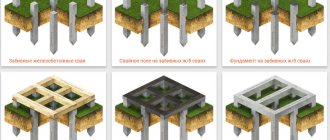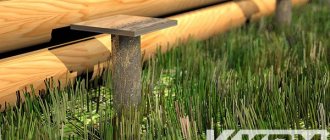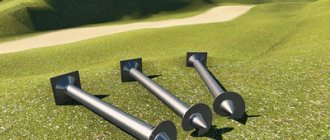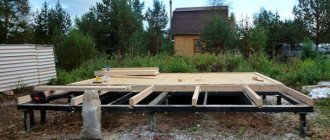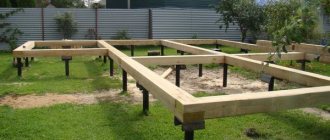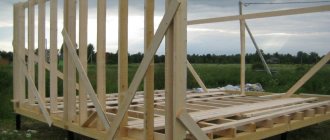It is unlikely that anyone will argue with the fact that each type of foundation is appropriate for certain objects under specific construction conditions. The foundation on screw piles, which is so popular among budget developers, is no exception, the information about which is very ambiguous. In general, the feasibility of building an object on such a foundation is determined by the type of soil, the topography of the construction site, and the total load. Below we will look at all the positive and negative aspects that developers notice.
Advantages
The reliability and durability of the planned structure depends on the correct choice of foundation. To evaluate the advantage of screw piles, it is necessary to analyze a number of factors:
- Price . Unlike the use of conventional columnar supports and shallow tape, the installation of screw piles will cost the developer 20-30% less. And if we are talking about the need to lay a reinforced concrete strip or monolithic slab to a considerable depth, then the savings will be much greater.
- Difficulty of construction . Labor costs for installing a pile-screw foundation directly depend on the type of structure of the future building, as well as the need to bury the supports below the frost line. In areas with particularly unstable soil, it is advisable to additionally install a drainage system. If you plan to build a small-sized building with low weight, then 3 people are enough to install screw piles. But for large-scale construction you will have to hire special equipment. hydraulic excavators, drilling rigs and other machines.
- Installation speed . To install the presented type of foundation, no excavation work is required. In addition, after screwing in the piles, you can immediately proceed to the next stage of construction. As a rule, installation of such a foundation does not take longer than 2 days.
- Seasonality . The installation of piles can be done at any time of the year, which is a definite advantage, because working with concrete mixtures in winter is accompanied by additional costs for anti-frost additives.
- Relief of the site . The use of screw piles is especially advisable if the site is characterized by large differences in height (up to 8 m). Reinforced concrete foundations also cope with this task, but it will cost the developer several times more.
- Soil subsidence . Screw piles are best suited for building foundations in conditions with moisture-saturated soil masses subject to heaving forces.
- Maintainability . If for any reason one of the supports bursts during operation, it can be quickly replaced with a new one without compromising the integrity of the structure.
- Thermal and waterproofing . The design feature of this type of foundation involves an air gap between the ground surface and the zero floor of the house. Thanks to this, the humidity and temperature of the earth do not in any way affect the structure itself.
- Prospects for the developer . In the future, if the owner of the house wants to increase the area of the building, it is possible to screw in additional supports to strengthen the structure.
- Life time . High-quality metal supports, the body of which is complicated by blades of various configurations, can last up to 80 – 100 years.
In what cases is it advisable to use a pile foundation?
A screw foundation is used in construction when there is unstable soil on the site, a sufficiently high groundwater level or false terrain. The main part of this foundation is screw piles in the form of pointed pipes with several blades for screwing into the ground. Screwing helps preserve the natural structure of the soil, and this has a positive effect on the strength of the foundation.
cross-section of pile screw foundation
The most appropriate installation of a pile-screw foundation:
- In places where there is moving soil. Piles are capable of passing through an area of unstable soil layers and crashing into a solid base. Such metal structures can perfectly withstand lateral loads.
- In harsh climates. In those regions where the soil freezes deeply and excavation work is impossible, a pile screw foundation is used. It can be installed even at very low sub-zero temperatures. The pile is able to pass through almost any frost layer.
- In flooded or inundated areas. If you want to build a house on the shore of a lake or river, you should use a pile-screw foundation - reviews from owners of “lake” houses say that this is quite an ideal option. In humid climates and wetlands, it is also impossible to do without it.
It turns out that this type of foundation can be installed anywhere. It is just not advisable to do this on rocky soil, since a stone foundation is an ideal foundation for a building.
Flaws
Along with the advantages of a foundation on screw piles, there are always disadvantages and limitations that need to be taken into account before starting construction.
The disadvantages of metal supports that are screwed into the ground include the following factors:
Not used for the construction of permanent multi-storey structures. This is primarily due to the fact that the installed piles are in no way connected to each other and are exposed to varying degrees by the influence of the soil.
Uneven shrinkage of the foundation does not lead to the formation of cracks and deformations in the walls of wooden houses, which cannot be said about brick and concrete structures.- Not suitable for all soils . The supports are not recommended for use in areas with rocky soil, a high content of stone layers and limestone deposits.
- Difficulties in constructing basements . When using screw piles, you can build a basement, but it will be a separate structure with its own walls. This option will lead to an increase in the cost of construction as a whole.
- Low quality metal . Many pile manufacturers skimp on the quality of metal and anti-corrosion coating. This leads to premature rotting and destruction of the supports, as well as possible deformations during installation. If the soil contains a large amount of chemically aggressive substances, the service life of the pile is reduced to 50 years.
- Susceptibility to bending loads . In areas with moving soil, metal supports may become deformed during operation, which will generally weaken the entire structure.
Quality of materials
What concerns us first of all:
- steel grade;
- metal thickness;
- support diameter;
- quality of the screw part of the pile;
- protective coating of the pile.
The thickness of the metal is the most important factor in durability in this case. Therefore, be sure to check the thickness of all elements: barrel, blade. Some manufacturers claim a thickness of 4 mm, but in reality they use 3.5, or even 3.2.
The steel grade also plays a key role in ensuring quality and reliability. For example, steel 20 is 10–15% more durable than steel 3, and tubing steel is 5-6 times more durable!
Surely you have already noticed that such piles are made of different diameters, and the blades of many of them are different. The most commonly used diameter is 108 mm - a universal option for most buildings. It is appropriate to build the lightest objects, such as a veranda, on thinner piles: it is easier to screw in the supports and construction is cheaper. But this is not the most important thing; we are concerned about the quality of the blade tip. A number of companies sell supports in which the blades are welded to the pipe. This means that they can easily be damaged during the tightening process (welded seams are not always made in compliance with all technologies). Hence the unsatisfactory opinion about such a foundation - developers simply choose low-quality piles!
Therefore, if you choose a welded tip, make sure that they are subjected to ultrasonic testing, or better yet, radiographic testing - feel free to ask the company for relevant reports to confirm. But do not forget that the so-called cast tips are also welded to the pipe, and reliability depends on the quality of the welds connecting the tip to the pile. Therefore, the ultrasonic inspection report must also accompany piles with a cast tip.
To protect yourself from careless manufacturers, carefully study information about the company. Pay attention to the data on its website, to how reliable the information in the “Contacts” section is (branch addresses, phone numbers, employee details). On the websites of some companies, they do not indicate city numbers, but a single federal number or a cell phone number, which is duplicated in other cities. Sometimes non-existent office addresses are indicated or not indicated at all. Very often there are not real company offices, but dealers who do not specialize in this construction.
The covering of piles deserves special attention. Not every manufacturer is ready to bet that the composition applied to the screw support will remain on it during the screwing process. The fact is that the entire body and blades, when installed, experience colossal friction against the ground, which may contain stones. And they perfectly remove low-quality protective coating. How to check the quality of the composition? Very simple! You can use the service of test screwing in a screw support or take a different route. Drive the sharp corner of the stone firmly across the pile. If you managed to get to the metal, the pile is unusable.
Today, the most reliable coating in terms of resistance to both friction and corrosion when the pile is in the ground is considered to be a coating based on polyurethane resins. This is a new generation of protection (the next after epoxy resins). However, in any case, no matter how good the coating is, it can be destroyed when screwed in. Therefore, when operating, you should primarily focus on the quality of the metal (thickness of the barrel, blades, steel grade).
It is a mistaken opinion that only standard (single-blade) piles are used in construction. For example, when constructing objects with height differences, above-water structures that are exposed to water flow, that is, where there are strong lateral loads on the foundation, two-bladed ones should be used, which are more resistant to this kind of load.
Observation of performers
Russian people are already accustomed to the fact that in our country (CIS countries) many construction technologies are not followed. Builders are trying with all their might to do more, faster, but not always better, so their clients are faced with situations of gross violation of the prescribed screwing conditions. In particular, some companies, before installing piles, facilitate the process by deepening them: they dig pits or leader holes, explaining this by saying that this is faster, and this measure does not in any way affect the quality of the construction.
Important! Construction should not be simplified by any digging of holes - the piles are screwed in from scratch! This is the only way to ensure the stability of the support and predict its further behavior. Therefore, if you turn to a construction company for services, be sure to monitor the progress of work on your own site, or better yet, make sure that this item (compliance with technology) is specified in the contract. When screwing by hand, the pit is dug not to facilitate the screwing process, but to accurately center the pile. The most important thing is that the pile is screwed into the untouched soil by at least 1 meter. With the mechanized method, there is no need to dig pits.
To protect yourself from unprofessional installation, check that the company has SRO approval, as well as the presence of a quality control department (technical control department) at the construction site. Do not hesitate to ask the company for a guarantee certificate for the work performed - this will be the key to high-quality installation and compliance with all building codes and regulations.
Independent work
If you have two or three assistants, then you can screw in the piles on almost any area suitable for this type of foundation. If you do not want to join the ranks of those who are then dissatisfied with the foundation, then the pile will have to be screwed in from scratch, without leader holes and other similar technology simplifications. The pile must be installed at right angles to a depth below the soil freezing level. This means that one of the workers must constantly monitor its position when twisting. Screwing in and out of the support with subsequent adjustment of its position is not allowed. After installation, the piles are cut to one level, filled with concrete, a head is installed on each support, and the piles are securely tied to ensure uniform distribution of loads on the base of the foundation.
Owner reviews and typical mistakes during construction
Builders who undertake to build a foundation with their own hands, without qualifications and experience, often violate technology, which negatively affects the service life of the structure itself.
Mistakes that are most often made during the construction of a pile-screw foundation:
- Refusal from concreting the internal cavity of the pile. If the support wall thickness is less than 4 mm, then the metal may tear during service as a result of severe freezing of the soil. Therefore, the inside of the pile must be completely filled with solution, preventing the development of internal corrosion. The reinforced structure will also provide the necessary rigidity to the foundation.
- Piles at different depths. This occurs due to the heterogeneity of the soil in the area. As a result, the uniformity of the bearing capacity of the foundation is disrupted. To avoid this, the piles are screwed all the way into solid ground.
- Deviation from the vertical plane. In the process of deepening a metal pillar, builders may stumble upon underground obstacles and the axis of the pile will shift to the side. The permissible deviation should not exceed 2 degrees, otherwise the stability of the structure will be impaired.
Shortcomings in pre-design calculations can lead to house swaying and other troubles. The reason for this can be found on the forum.
For those who doubt the choice of foundation, it will be useful to read the reviews about houses on a pile-screw foundation, presented on the construction forum in the topic: “What is wrong with screw piles?”
Pile foundation after construction
Consideration of possible problems after the construction of structures on pile foundations and the probable causes of their occurrence will help to avoid mistakes when selecting and installing structures.
| Problem | Probable Cause |
| Subsidence in the ground |
|
| Corrosion of supports |
|
The declared service life of pile foundations reaches 100 years. There is no actual evidence of such capabilities due to the fact that the technology began to be used relatively recently. Manufacturers separately stipulate the conditions under which they guarantee the possibility of long-term operation of pile supports:
- accuracy of engineering calculations when designing foundations, taking into account data obtained from soil research (a test pile is often installed for these purposes),
- correct selection of piles by type and geometric parameters,
- high quality of supports (sufficient metal thickness, use of durable alloys, presence of an anti-corrosion layer), absence of violations during the installation stage.
In what cases is a foundation on screw piles suitable?
The choice of foundation is directly related to the type of construction of the future structure, the physical and chemical properties of the soil on the site, as well as the owner’s desire to save on construction.
The use of technology associated with screwing screw piles into the soil is beneficial if:
it is planned to build a wooden, frame, panel house or other lightweight structure;- hard soil rocks are not very deep and there is no need to build up piles;
- the soil on the site is saturated with moisture, prone to freezing, but no noticeable horizontal movements of the earth layers are observed;
- The terrain of the site is uneven, with large differences in height.
Given the restrictions on the use of piles, it is necessary to carefully analyze the geological conditions. In some cases, it is advisable for the owner to hire a team of installers rather than do the construction with his own hands, or choose a different type of foundation.
Obstacle when installing a pile manually
Another problem that can be encountered while working with piles is stopping the pile from moving deeper due to the encounter with a solid object. Depending on the density of the object and the stage of laying the pile-screw foundation, there are several ways to solve the problem. With a minimum density, you can try to pass a bad section with great effort, but if it does not give in, most likely you will have to move the entire foundation a little to the side.
It is clear that moving the first pile is not difficult and not a pity, but what to do if the problem arose in the middle of construction? In order not to have to make extra efforts, experienced workers recommend starting the installation of the foundation with corner piles, then moving on to the piles under the load-bearing walls and to all the rest. And if any pile hits an obstacle, but it is not angular and is not intended for a load-bearing wall, it can be screwed to a depth that is not as great as all the other piles. Naturally, if she has already walked at least a meter.
If there are too many obstacles on the site, then there is a high probability that there is a type of soil unsuitable for piles and there are hard layers. In this case, you will have to choose a different type of foundation. To avoid such problems, you can order test drilling before starting construction, which will tell you whether it is worth working further on the site with piles.
The role of concreting piles and its underestimation
Final concreting of the pile body plays a significant role, as it ensures
- Design bending stiffness of the pipe
- Internal protection of the pipe body from corrosion
Sometimes, when installing piles on their own, the developer ignores this stage. Unscrupulous teams are also guilty of this - after all, the concreting process takes a significant amount of time. Often, low-quality concrete or concrete that does not meet the standards is used, or the pouring is done carelessly, not to the edge of the pipe, etc.
As a result, the pipe does not have sufficient rigidity, especially if pipes with a wall thickness of up to 4 mm are used. In addition, it rusts quite quickly from the inside, which significantly reduces the durability of the foundation.
Filling the pile cavity with concrete
The need for anti-corrosion treatment of protruding parts of piles
As experience shows, it is the part of the pile that protrudes above the ground, especially at the point of contact with the ground, that is exposed to intense influence of external adverse factors. Intensive pockets of corrosion develop here. To avoid them, the pile must be covered with an additional layer of anti-corrosion material - it is recommended to use mastic.
Since this process also takes time and is also associated with inconvenience due to increased labor intensity, builders often omit it. This is a gross violation that will lead to a significant reduction in the service life of the foundation.
Bituminous coating of the end of the pile
Advantages of using screw piles
As mentioned above, the main advantage of a screw foundation is quick and simple installation without the use of special construction equipment, but, in addition, it should be noted here:
- high load-bearing capacity, which depends on the diameter of the pipe;
- significant reduction in costs for the construction of the foundation part of the building;
- no need to plan and organize access roads;
- environmentally friendly design, without disturbing the natural structure of the soil;
- the possibility of constructing a foundation on all types of soil, except stony and rocky;
- simple processing and alignment of the heads when installing a supporting grillage frame;
- the possibility of using monolithic concrete beams or shaped metal products to construct a grillage;
- the possibility of using this type of foundation in any climate zone;
- durability of the structure, provided installation technology is followed and measures are taken to protect against corrosion;
- lack of a complex of preparatory and excavation work during the construction of the foundation;
- versatility of the design, allowing the use of screw supports for various structures;
- the possibility of expanding the base area over time.
Why does the house rock?
Several factors may contribute to this:
- high location of piles above ground level;
- incorrect strapping device;
- insufficient screw-in depth;
- small diameter or thin wall of metal pipes;
- poorly made blades;
- making a pit that is too deep;
- installation of an insufficient number of supports under load-bearing walls;
- exclusion from calculations of corrections for weak characteristics of soil layers;
- lack of heads;
- performing work in winter;
- insufficient spatial rigidity of the frame structure of the ground part of the building.
Each of the reasons causes different consequences, which ultimately influence the fact that the house on stilts begins to sway. For example, due to an incorrect determination of the bearing capacity of the soil or external load, the structure begins to sag. And the result of small deepening of the blades, when they fall into the freezing zone, can be the bulging of screw piles due to the influence of frost heaving forces on them. In this case, the house or its individual corners will rise above the ground in winter, and lower in spring.
To avoid problems associated with insufficient screwing of piles, the procedure for trial installation of 2-3 supports on the site being built will help, although there is an opinion that this way only determines the presence of stones in the ground.
If a house installed high above the ground (more than 40 cm) is shaking, then diagonal tying of screw piles will help correct the situation. As a rule, it is made of a metal profile, which is placed obliquely between pipes protruding above ground level. In this case, the rigidity property of the triangle figure is used. All piles are subject to strengthening, regardless of what walls they are under.
The dimensions of the pipes affect the bearing capacity of the supports, which must be taken into account at the stage of calculating the number of piles for the foundation. Their number and diameter are inversely proportional to each other. An imbalance leads either to an overexpenditure of material resources or to a weakening of the supporting structure of the building. In the latter case, subsidence and subsequent swaying of the structure occur due to the loss of the design position of the screw piles.
The reason that a house on screw piles begins to wobble is often the absence or inadequate strength of the horizontal frame (grillage), as well as its partial destruction. This design must be carried out in accordance with the design. Violation of integrity can occur due to non-compliance with the technology of the strapping device or in the case of the use of low-quality, cheap materials. It should be remembered that savings are not allowed here.
The issue of excessive thrift also applies to the acquisition of screw piles. Preference should be given to products from well-known brands. It is not recommended to install the house on supports made independently or at home-made enterprises, just because the low cost of the products suits you. Factors influencing the swaying of a structure can be:
- fallen off blades;
- thin walls of a metal pipe;
- lack of a high-quality protective layer, which contributes to the emergence and development of corrosion processes.
The construction of buried pits when installing screw piles under a house deprives the pipes of a significant part of the vertical supporting surface. No matter how carefully the compaction of the backfill is carried out, the density of the compacted soil cannot be achieved. Over time, the supports will begin to loosen, causing the house to sway. Installing spacers or wedges will help correct the situation.
Photo taken from the site https://inf-remont.ru/
A similar situation often arises when piles are screwed into frozen soil, which loses its strength when thawed. When installing foundation supports in winter, experts do not recommend immediately loading them with the frame of the house. You should wait for a thaw and adjust the position of the pipes. This advice does not apply to regions with permafrost soils.
The reason for the instability of the position of a house on stilts may be the lack of proper fastening of the frame of the ground part. Often, installing diagonal supports between posts or additional fasteners will eliminate defects that cause swaying. In this case, problems are not associated with the foundation.
The choice of an acceptable option for strengthening loose piles should be left to specialists capable of conducting professional expertise.

